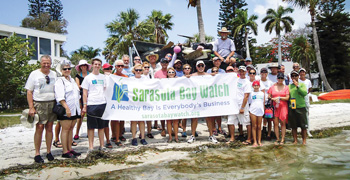Join in the Sister Keys clean up

submitted
Participants in the Sister Keys clean up pose with a truck
full of trash collected from the islands.
It’s a chance to see first-hand the restorative power of nature, while exploring the largest undeveloped group of islands between Tampa Bay and Charlotte Harbor. You get this and much more when you participate in the Fifth Annual Sister Keys Clean-Up hosted by Sarasota Bay Watch and The Mar Vista Dockside restaurant Saturday May 11. Be a part of the effort to protect and enhance Sarasota Bay; enjoy lunch by the water and if you don’t have a kayak or boat, a shuttle to the islands will be provided courtesy of the Kathleen D, a sailing catamaran.
The Sister Keys were protected in 1991 through the efforts of a coalition of citizens named the Sister Keys Conservancy partnering with the town of Longboat Key. In 2007-08 a one million dollar mitigation project removed all invasive floras, replacing them with native species and creating a two-acre wetland. The islands are now one of the best examples of a thriving native marine environment on the west coast of Florida.
In 2010, Sarasota Bay Watch adopted the Sister Keys through an agreement with Longboat Key. Yearly clean ups have been conducted since 2009, and plans are being formulated to work with Longboat Key to maintain the islands’ natural diversity. The Sister Keys are truly a shining example of the restorative power of nature.
To appreciate the changes that have taken place on the Sister Keys, participants can compare them with Jewfish Key, just to the north. The Sister Keys were also covered with Australian pines before the restoration in 2007. By removing the pines the shade and acid forming straw were eliminated, creating a healthy and robust environment.
Planting native flora and the creation of a wetland (one of the most important and productive habitats in nature) shaped the environment you’ll see where diverse species from fiddler crabs to ibis and roseate spoonbills abound. The waters that surround the keys are filled with shallow sea grass beds and are one of the most important habitats in Sarasota Bay. These areas are a nursery for fish like the snook, redfish, sea trout and flounder. They provide a home, protection and a food source for countless other species like shrimp, crabs, oysters, scallops and even manatees.
Clean ups not only help maintain the natural diversity of the islands, but also give participants a way to learn about the bay and get invested in the continued health of the resource. Future events are being planned to maintain the restoration by keeping invasive species from once again gaining a foothold on the islands.
The success of events like the Sister Keys clean up shows that the public is eager to get involved with the health of the bay. When you give citizens an opportunity to get their feet wet they gain a new appreciation of the resource.
Sarasota Bay Watch was formed in 2008 to foster just this kind of community involvement. Its mission continues to be the protection and restoration of Sarasota Bay's ecosystem through community education and citizen participation.
Projects like the Sister Keys Clean Up provide an opportunity to network with partners like, Mote Marine Laboratory, the Chiles Group, Save Our Seabirds, the Sarasota Yacht Club, the Sarasota Sailing Squadron, The Longboat Key Garden Club, Audubon and the Sarasota Bay Estuary Program.
Now is a great chance for you to join in the cause. Where else can you get a morning on the water, lunch by the bay and the feeling that you’re helping to preserve a shining example of the natural diversity of Sarasota Bay? Sign up by visiting www.sarasotabaywatch.org or by calling Sarasota Bay Watch at 941-918-2700.

